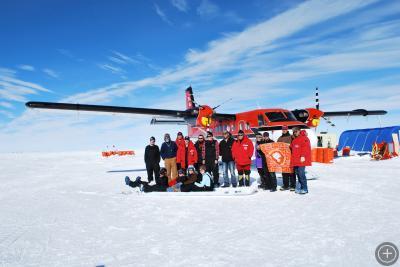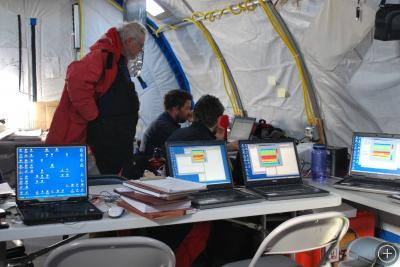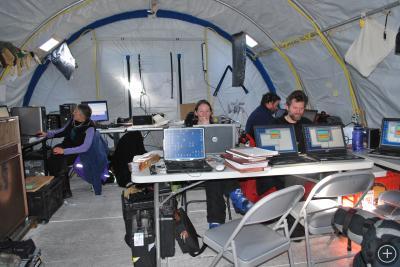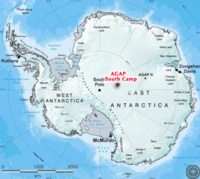A Typical Day in an Atypical Place
January 5, 2009
AGAP-SOUTH CAMP, ANTARCTICA– Once we began flying at AGAP, we quickly got into a routine of collecting data, downloading, archiving and running a quality control procedure. We are operating 24 hours a day in two teams. There is almost always someone at the computer copying or reviewing data. Though there have been days that have been flawless, our peak performance of 4 flights per days has been interrupted by weather, which was particularly bad around the New Year.
Life at AGAP revolves around the forecast… which is not always the actual weather. The weather determines if we’ll be allowed to get off the ground and which direction we can point our airplane, SJB. Assuming the weather cooperates, a day in the science tent follows a certain rhythm, paced by the arrival and departure of SJB.
The day begins with the rising of our day shift operators, Nick and Michael. They pop into the science tent eager to know how things went the night before. The flight plan for that morning has usually been selected a day or two in advance. On the morning of the flight, it is relayed to the pilots and our flight operator, the scientist who makes sure all our equipment is up and running before and during the flight.
Thirty minutes before we leave the ground, our base stations have to be on. Base stations collect a similar type of data as equipment on the plane, but are in a fixed position just outside our science tent. We have base stations for the GPS and magnetic data. The GPS base station is required so we know where the plane is relative to camp. The magnetic base station is needed to capture how the magnetic field is varying in time, while SJB’s onboard system captures how the magnetic field varies in space. The Earth’s magnetic field varies in time in part because of currents in the liquid part of the core of the Earth (i.e. the liquid outer core). The magnetic field varies in space because of different rock types under the ice. By collecting data at the base station and onboard SJB, we are able to separate the changes in time, which we are not studying, from the changes in space which relate to the rocks we see on the radar lines.
While SJB is in the air, we are in the office making copies of the data. This is particularly time consuming for the radar data because of its volume. Copying the radar drives takes so long that we have one computer and one person, Chris, designated to the task. After the radar copy is complete, a sampling of the data is plotted and reviewed. Meanwhile, similar procedures are executed on the magnetic, GPS and laser data from the previous night’s flight. Although not an exciting aspect of the work, the QC (quality control) step is essential. It is during this step we identify survey lines that might need to be reflown and also get a sense of how well our system is working.
When the plane returns, it is greeted by a flurry of activity. The camp staff are ready to refuel, Chris or Nick will take blank hard drives out to the airplane and swap them for the ones containing the radar data for the flight, Stefan and Dan check on the status of the gravimeter. The flight operator brings in written logs and data on memory cards to archive and copy. The plane only sits unattended in between the day and night shift, while the whole camp is having dinner or on bad weather days.
The pace of the survey makes the days go by quickly. I keep forgetting that the GAMSEIS team is done with their work and gone already! I still expect them to come back from an installation and be sitting in the galley at dinner. With 4 flights a day, we are just barely keeping up with the in-flux of data, which is good because you need something to do in this place or you’ll feel trapped. Fortunately, I never feel trapped when surrounded by science!














Thanks, loved to read!